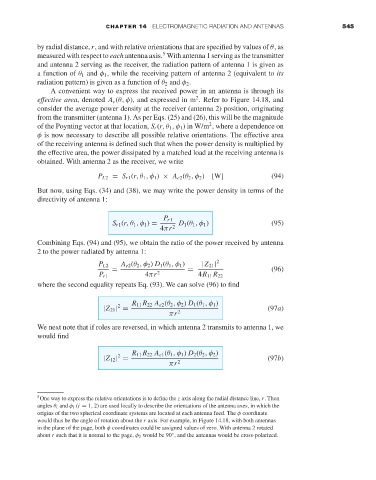Page 563 - Engineering Electromagnetics, 8th Edition
P. 563
CHAPTER 14 ELECTROMAGNETIC RADIATION AND ANTENNAS 545
by radial distance, r, and with relative orientations that are specified by values of θ,as
5
measured with respect to each antenna axis. With antenna 1 serving as the transmitter
and antenna 2 serving as the receiver, the radiation pattern of antenna 1 is given as
a function of θ 1 and φ 1 , while the receiving pattern of antenna 2 (equivalent to its
radiation pattern) is given as a function of θ 2 and φ 2 .
A convenient way to express the received power in an antenna is through its
2
effective area, denoted A e (θ, φ), and expressed in m . Refer to Figure 14.18, and
consider the average power density at the receiver (antenna 2) position, originating
from the transmitter (antenna 1). As per Eqs. (25) and (26), this will be the magnitude
2
of the Poynting vector at that location, S r (r,θ 1 ,φ 1 )inW/m , where a dependence on
φ is now necessary to describe all possible relative orientations. The effective area
of the receiving antenna is defined such that when the power density is multiplied by
the effective area, the power dissipated by a matched load at the receiving antenna is
obtained. With antenna 2 as the receiver, we write
P L2 = S r1 (r,θ 1 ,φ 1 ) × A e2 (θ 2 ,φ 2 ) [W] (94)
But now, using Eqs. (34) and (38), we may write the power density in terms of the
directivity of antenna 1:
P r1
S r1 (r,θ 1 ,φ 1 ) = D 1 (θ 1 ,φ 1 ) (95)
4πr 2
Combining Eqs. (94) and (95), we obtain the ratio of the power received by antenna
2to the power radiated by antenna 1:
P L2 A e2 (θ 2 ,φ 2 ) D 1 (θ 1 ,φ 1 ) |Z 21 | 2
= = (96)
P r1 4πr 2 4R 11 R 22
where the second equality repeats Eq. (93). We can solve (96) to find
R 11 R 22 A e2 (θ 2 ,φ 2 ) D 1 (θ 1 ,φ 1 )
2 (97a)
|Z 21 | =
πr 2
We next note that if roles are reversed, in which antenna 2 transmits to antenna 1, we
would find
R 11 R 22 A e1 (θ 1 ,φ 1 ) D 2 (θ 2 ,φ 2 )
2 (97b)
|Z 12 | =
πr 2
5 One way to express the relative orientations is to define the z axis along the radial distance line, r. Then
angles θ i and φ i (i = 1, 2) are used locally to describe the orientations of the antenna axes, in which the
origins of the two spherical coordinate systems are located at each antenna feed. The φ coordinate
would thus be the angle of rotation about the r axis. For example, in Figure 14.18, with both antennas
in the plane of the page, both φ coordinates could be assigned values of zero. With antenna 2 rotated
about r such that it is normal to the page, φ 2 would be 90 , and the antennas would be cross-polarized.
◦

